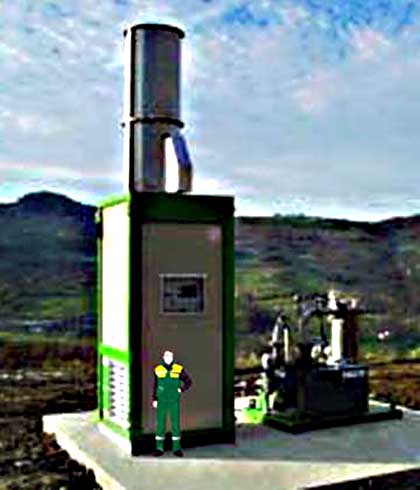Community Scores Major Win as City Rejects Oil Company Plan for Gas Burner

24-foot-high CEB 800 gas burner with human figure to show scale. Zoning Administrator ruled that it belongs in an industrial zone, not next to homes and an AIDS clinic.
Leslie Evans
A three-year fight ended with victory for a West Adams community when Los Angeles Associate Zoning Administrator Charles Rausch on June 30 said no to an oil company’s plan to install a massive gas burner in a residential neighborhood. The case involved the Murphy Drill Site at 2126 W. Adams Blvd., owned by the Freeport-McMoRan Oil and Gas Company, a subsidiary of the world’s largest copper mining company.
The Murphy site operates 22 active oil wells on 3.25 acres of land leased from the Catholic Archdiocese of Los Angeles. The drill site is surrounded by a convent, an AIDs clinic, an apartment house, and a string of single family homes.
In the summer of 2013, Freeport filed a request with the L.A. Planning Department to install a CEB 800 gas burner to flare off excess natural gas, a byproduct of oil extraction. The site uses part of the gas to run micro turbines that generate a third of its electricity; they pump some of it back into the ground into 7 induction wells, and the remainder was being sold to the Southern California Gas Company. The company told the Planning Department that a small excess that couldn’t be sold needed to be burned off, and that was the reason to install the new flare burner, a 24-foot-high piece of equipment.
The community did not initially object to the burner, but did oppose its planned location. About two-thirds of the drill site is used for the oil facility. That faces Adams Blvd. on the north, and is surrounded by a high concrete block wall. The remaining third of the property, on the south, faces 27th Street and is landscaped as parkland. The company proposed to put the new burner on the outside of the south wall, in the parkland section. The United Neighborhoods Neighborhood Council (UNNC) opposed this but lost when the burner was approved in a December 2013 Zoning Administrator ruling. The council and several local residents, including UCLA historian Michael Salman, appealed the decision. They were supported by Los Angeles City Council President Herb Wesson.
As the neighborhood council and local residents learned more about the gas flare burner they concluded that it was too dangerous to be operated in close proximity to homes. Jeff Camp, president of the UNNC and a member of Southwest LAPD’s CPAB chapter, told the L.A. Times July 6, “To have a gas flare burning right next to an apartment building – it was a concern right up front.” The latest decision, siding with the community, is the result of their appeal.
The clincher in rejecting the burner for Associate Zoning Administrator Rausch was input from the Fire Department, which the previous administrator who approved the project had failed to secure. Rausch’s June 30, 2016, decision reported:
“The Fire Department has expressed concern over the fire safety of an open air flare during Santa Ana wind conditions when debris from nearby palm trees and other jetsam could blow through the flare, ignite and become flaming missiles in a residential neighborhood during high wind conditions.” Rausch ruled that this kind of equipment could be installed only in industrial zones.
Ironically, Freeport-McMoRan weakened their own case by insisting that the CEB 800 burner was an incidental accessory, not essential to the oil extraction. Their aim was to avoid an environmental impact review that could have been triggered if they installed major new equipment. But the flare burner is needed now, far more than when it was first proposed three years ago.
Excess natural gas cannot legally be let loose in the air, and there are only a few ways to get rid of it. Whatever part can’t be used by the site’s electric generators or be reinjected into the ground can only be removed from the site via the underground pipe that goes to the Gas Company. But the Gas Company has recently canceled their agreement to buy gas from the Murphy site. Stove and home furnace gas is pure methane. The stuff that comes out of the ground at the oil drill site is a mixture of methane with propane and butane. The Gas Company had grandfathered the purchase in, but has now decided they don’t want to deal with the impurities.
That means that the amount of natural gas that would have to be flared away has increased monumentally. The company in their presentation to the Zoning hearing put it at 400,000 cubic feet a day, enough to heat and run stoves in some 3,650 California homes. This may mean that Freeport-McMoRan will have to drastically cut back production from its 22 wells.
Freeport-McMoRan bought into the oil business only in 2013, paying $19 billion to the Plains Exploration Company for its holdings, which included the large Inglewood Oil Field as well as the Murphy and Jefferson drill sites in West Adams. In large part due to the 2014 crash in oil prices, the company is now $20 billion in debt and is said to be trying to sell all of its oil interests for just $3 billion.
Community members, supported by Herb Wesson, have also called for the installation of state of the art emission monitoring systems, something provided for in city code, which calls for installing “proven technological improvements” at oil facilities. “We don’t require fire alarms only at buildings that have already had fires,” Michael Salman told the L.A. Times.
Comments
Leave a Reply
You must be logged in to post a comment.




